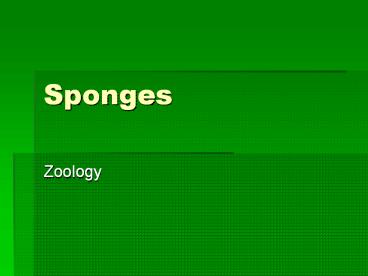Sponges - PowerPoint PPT Presentation
1 / 15
Title:
Sponges
Description:
Sponges Zoology Bellringer Get out a sheet of paper. Fold it for Cornell notes. Answer this question at the top of your paper. List three words that you think of when ... – PowerPoint PPT presentation
Number of Views:81
Avg rating:3.0/5.0
Title: Sponges
1
Sponges
- Zoology
2
Bellringer
- Get out a sheet of paper. Fold it for Cornell
notes. Answer this question at the top of your
paper. - List three words that you think of when you think
about a sponge.
3
Sponges
- Simplest animal
- Belong to the Phylum Porifera
- Porifera comes from Latin words
- Porushole
- Ferrecarry
4
Why Porifera?
- Sponges are named for the way that sponges get
their food! - Sponges filter feed.
- They siphon materials in through their pores
(holes). - They filter the water to get food and absorb the
food into their cells.
5
What do they look like?
- Rough
- Porous (filled with lots of empty space)
- Can be many different colors (red, blue, yellow,
etc) - Round or tube shaped
- Asymmetrical body plan
6
What does a sponge do?
- Provides a habitat for worms, shrimp, snails, and
sea stars - Provides a habitat for photosynthetic bacteria
and protists - Provides a food source for some snails, sea
stars, and fish
7
How does a sponge eat?
- The inside of the two sponge layers is lined with
specialized cells called collar cells. - Collar cells beat flagella so that water will run
through the pores of the sponge. - Cells pull the food and oxygen out of the water
so that the sponge can use them.
8
Why does a sponge need oxygen?
- What important cell process uses oxygen?
- Why does the cell complete this process?
9
Answers
- Cell respiration
- To release energy for use in the cell and body
10
Do sponges move?
- No. Adult sponges are sessile!
- When they are young, larvae move through currents
to find a suitable habitat. - They attach and grow when they find an area to
live.
11
Where do they like to live?
- Most live in the shallow waters near the
shoreline of saltwater or freshwater. - Many live in colonies (groups).
12
Reproduction in Sponges
- Most sponges reproduce sexually.
- Most sponges are hermaphrodites (have male and
female reproductive parts.)
13
- Eggs are released in the water by one sponge.
- Sperm are released by another sponge.
- The egg is fertilized and becomes the larvae that
travels until it finds a habitat.
14
How do sponges protect themselves?
- There are two modes of protection
- Spiculesspiny processes that deter other animals
from eating the sponge - Chemicalsreleased to deter animals and even harm
them
15
Why are sponges important to humans?
- The chemicals used for protection are being
researched to provide treatments and cures for - Viral infections
- Bacterial infections
- Cancer treatments
- Other medications































